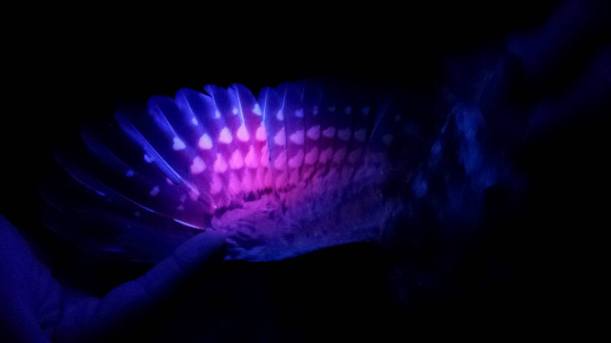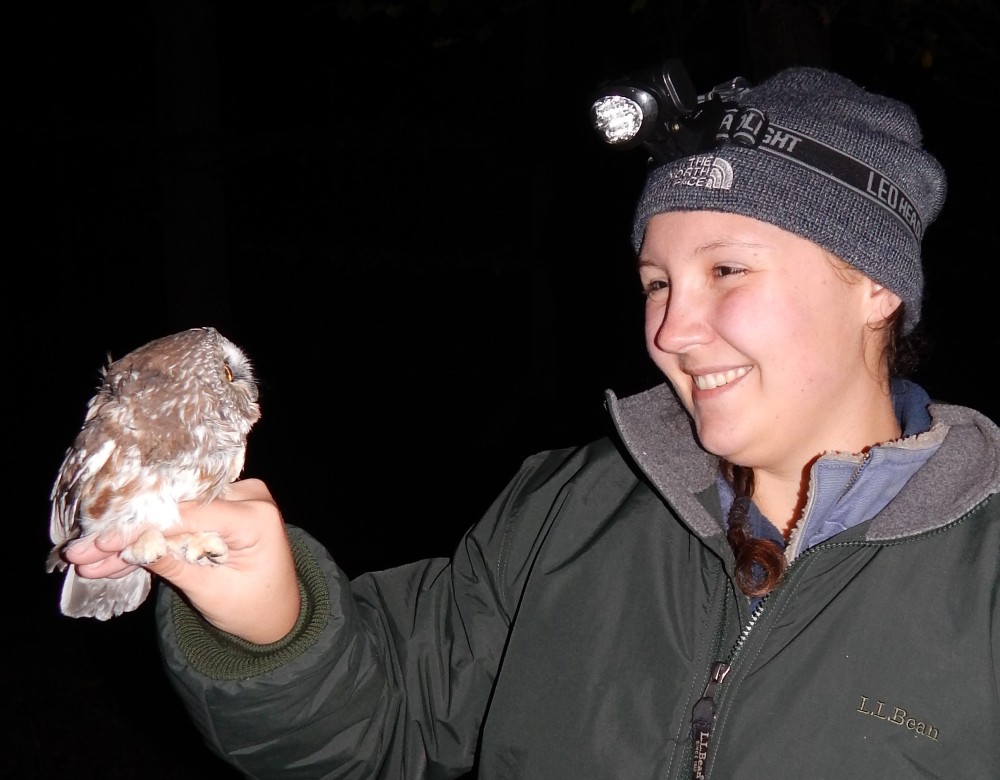Every owl banding season finds me praying for cold weather and north winds.
That’s not something I would typically say. I am pretty thoroughly a child of summer. I love to be able to walk outside in a t-shirt and shorts and enjoy the balmy nighttime breeze on my skin. However, October finds me bundling up in a long sleeved t-shirt, sweatshirt, vest, coat, hat, gloves – you get the point – to sit out in the dark woods from sunset until midnight hoping for an owl. And Northern Saw-whet Owls don’t move through Indiana in large numbers without a cold breeze at their tail.
I suppose I should start off by explaining why I’m catching owls in the first place. Normally I’m a big advocate of leaving wild animals alone. In this case, we catch them to put a unique band on them that allows us, through a network of banding stations all over the country, to understand more about their movements and basic biology. Basically, we’re figuring out where these owls go, what drives them to migrate to different locations, and how they physically handle the stresses of migration. Information like this forms the basis of conservation programs and management strategies, ultimately helping owls persist in the wild.
It seems like catching tiny owls in dense forests in the dark would be next to impossible. In reality, the owls come to us. How? The first step is to set up capture devices called mist nets. No, I’m not talking about butterfly nets. These nets look more like volleyball nets with several modifications. First, there are five strings running between the poles that the mesh attaches to. Each length of mesh droops from its string to form a “bag.” So, you end up with five long bags running from one end of the pole to the other. The highest string is at the top of the pole and the lowest bag almost brushes the ground. When it’s all stretched out, the mesh is really hard to see even for us (we have definitely caught a Danielle more than once). So basically the owl flies right into the mesh, drops into a bag, and gets tangled up until we go retrieve it. We also play an owl call to attract them to the areas where the nets are set up.

Getting the owls out of the net takes some skill. The nets are designed to allow their head and wings to go through. So, you have to figure out which side they hit the net on and start untangling. I usually start with their feet and work my way to their heads. They’re usually surprisingly okay with the whole situation. They sometimes click their bill to let you know they’re not super happy (which is the cutest) but other than that they seem to have accepted their fates. Getting them out can take anywhere from a few seconds to several minutes depending on how tangled they are and how cold and clumsy the bander’s fingers are.
Next, we take them down to our station for processing. Each owl is fitted with a uniquely numbered band so we and other stations know if they have been captured before. We weigh them and measure their wings and tails to determine whether they’re male or female – females are slightly bigger, which is true of many birds of prey. They usually weight somewhere between 70-100 grams, which is about the weight of a bar of soap. We also check how much fat they have and how big their flight muscles are, which can tell us a little about how much food they have been able to find on their migration and how long their journey has been. Finally, we look at their wing feathers to figure out their age. They have a pigment on their flight feathers that glows in black light, and since the pigment wears off as the feather ages we can tell if it was grown this year or earlier. The pattern of new and old feathers shows us the bird’s age.

Finally, someone gets to let the owl go. They turn off their light, walk down the trail, and place the owl on their arm. Usually it rests there for a moment, which is pretty magical. You’re just out in the cold dark, far from everything, with the warm weight of an owl resting on your jacket. Then it flies away, and you’re off to catch another.

We usually start catching in mid-October and go until the first week of December. That means a few banders have to coordinate to run the station every night for nearly two months, often through bitter cold and sometimes into early morning hours. Do we sometimes feel like we’re freezing in our camp chairs? Yes. Are we often exhausted the next day? Yes.
Is interacting with these amazing creatures worth it every time?
Yes.

Good article, Danielle!
LikeLike
Thank you!
LikeLike